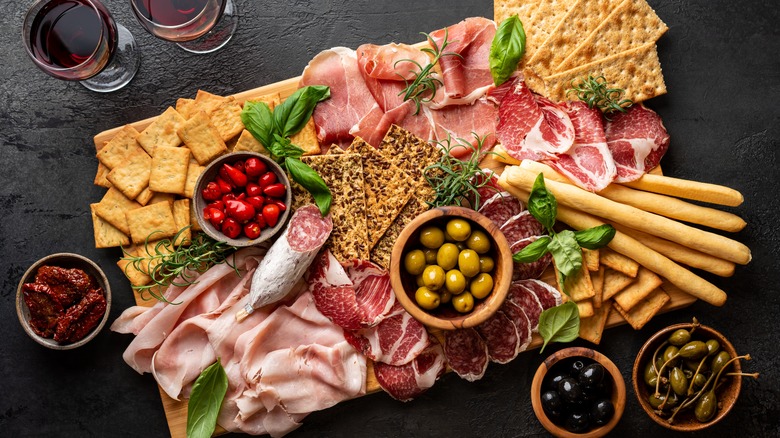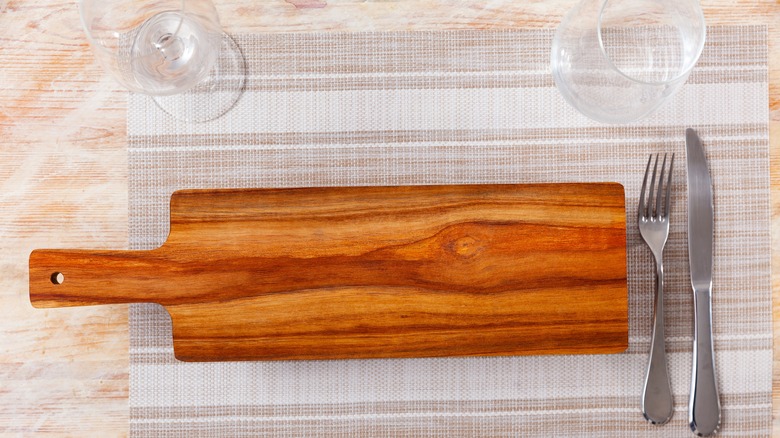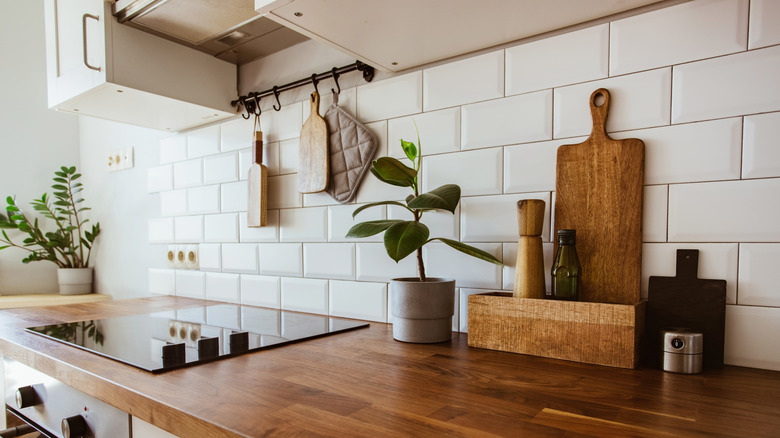The Common Cleaning Mistake That Ruins Charcuterie Boards
Artfully arranged charcuterie boards are a pleasure for both the eyes and stomach, and they've become more and more popular over time, as evidenced by the nearly 200 million views garnered on TikTok. But, it's not just the carefully curated cheeses, nuts, fruits, and other small-bite delights that make the arrangements so enjoyable. The board itself is also an important visual and structural element and one that can easily be compromised due to improper maintenance.
Charcuterie and cheese boards are typically made of wood and, thus, are prone to warping if they're not cleaned using the correct methods. The most common mistake is soaking the board in water, although exposing it to the dishwasher's heat is likewise putting it at risk. The correct way to wash the board is with simple soap and water. You'll also want to make sure to wash both sides of the board, since concentrating too much on a single side can eventually lead to warping as well. Hand drying it with a clean towel after rinsing is also a must, as leaving the board to dry in a dish rack or on a countertop can also have consequences.
There are other maintenance tips to keep in mind, too, like using disinfectants and periodically conditioning the wood. But the most important thing to remember for a long-lasting charcuterie board is to avoid the most common cause of warping — and that is soaking it.
How to properly clean and condition your charcuterie board
Charcuterie boards are produced from a wide variety of woods. But, even if you own one made from high-quality options like walnut or maple wood, some damage will likely accrue over time — even if you avoid soaking and dishwashers. While it's advised to rinse and then wash your board with just soap and hot water, it's also imperative to use the right tools to do the job, such as a soft sponge or dishcloth. Because another thing that can damage the board is harsh, abrasive materials like steel wool or rough sponges.
Since bacteria can remain on the surfaces from meats, cheeses, and other food items — especially within the scratches on the wood, or in the cut marks from knives — disinfecting it before a final rinse and towel drying is also recommended. A solution that blends water with white vinegar works well, as does a bit of lemon juice.
Wood boards will also benefit from occasional conditioning. Although you'll want to clean your board after every use, conditioning is something that only needs to be done every four uses or so, or if the board appears noticeably dry. Mineral oils are the best conditioner (apply thinly but evenly), but avoid vegetable oils or olive oils as they can cause smells to linger over time.
Removing tough stains and other maintenance tips
Keeping your charcuterie board properly cleaned and conditioned should help it to retain a good appearance over years of use. Inevitably, some damage will occur, either via minor cuts and scratches or from the stains of the food arranged on top. For the former, sanding can help restore the board's finish. A medium grit sandpaper (in the 80- to 120-grit range) is preferred for deeper marks, while a finer option (up to 180-grit) is ideal for final touchups.
Stains from food, meanwhile, can be removed with salt and lemon. Cut the citrus in half and use to gently scrub the salt into the wood's surface. The acid in the lemon will help lift the markings while the salt acts as a soft abrasive to further do the trick.
Most good charcuterie boards will have a hole cut in the end so that they can be hung in the kitchen, which is a great way to store it. This isn't strictly necessary, but improper storage should be avoided. Any closeted area without airflow is bad, as this can lead to moisture buildup and more warping.



